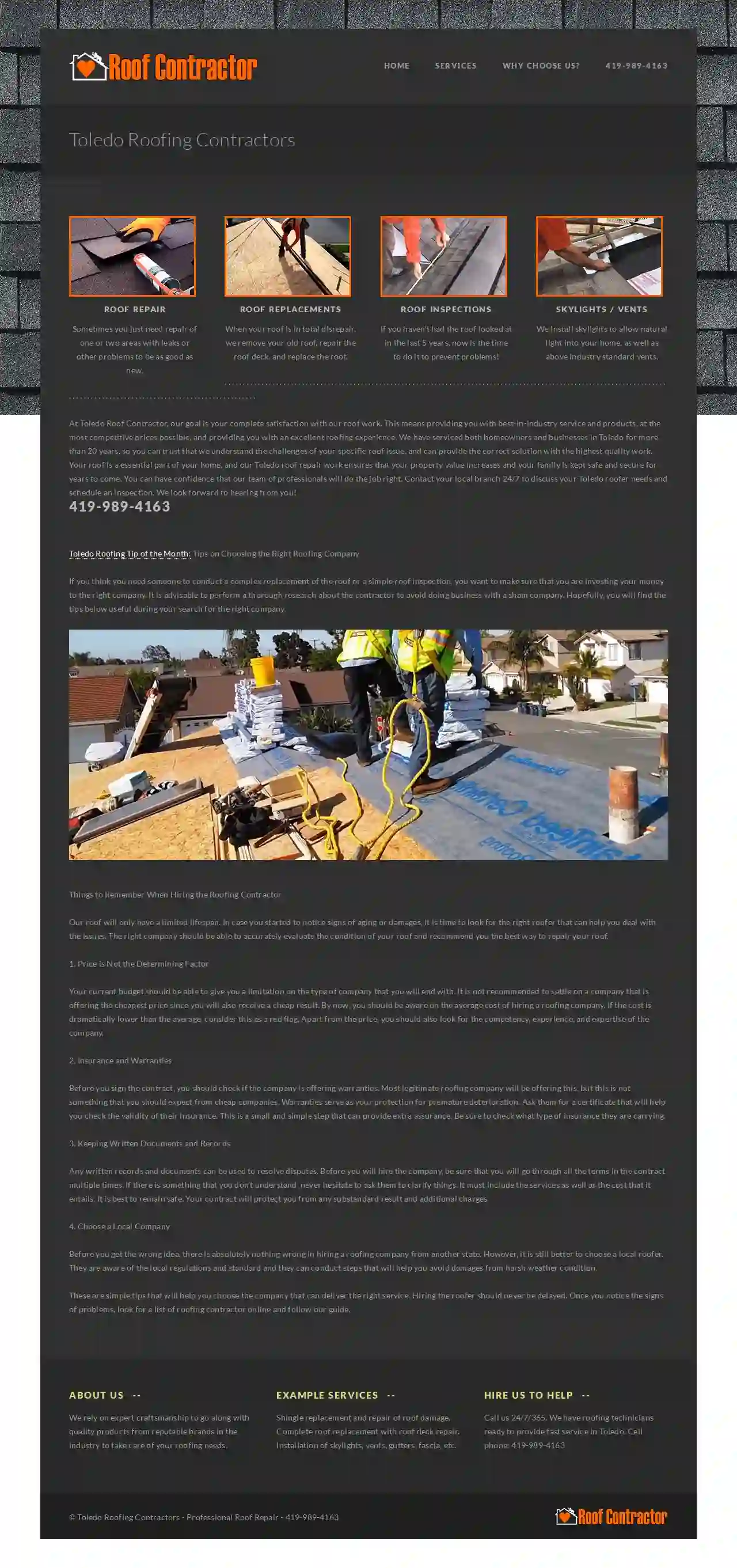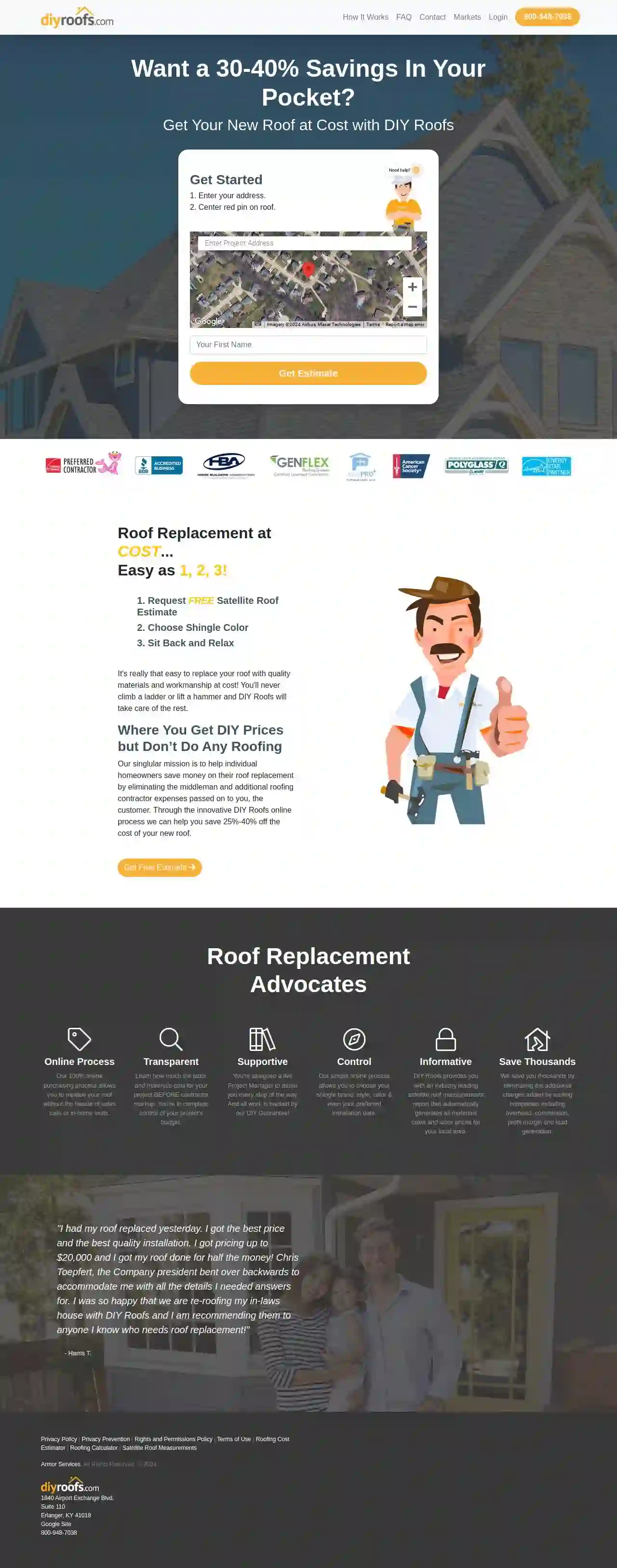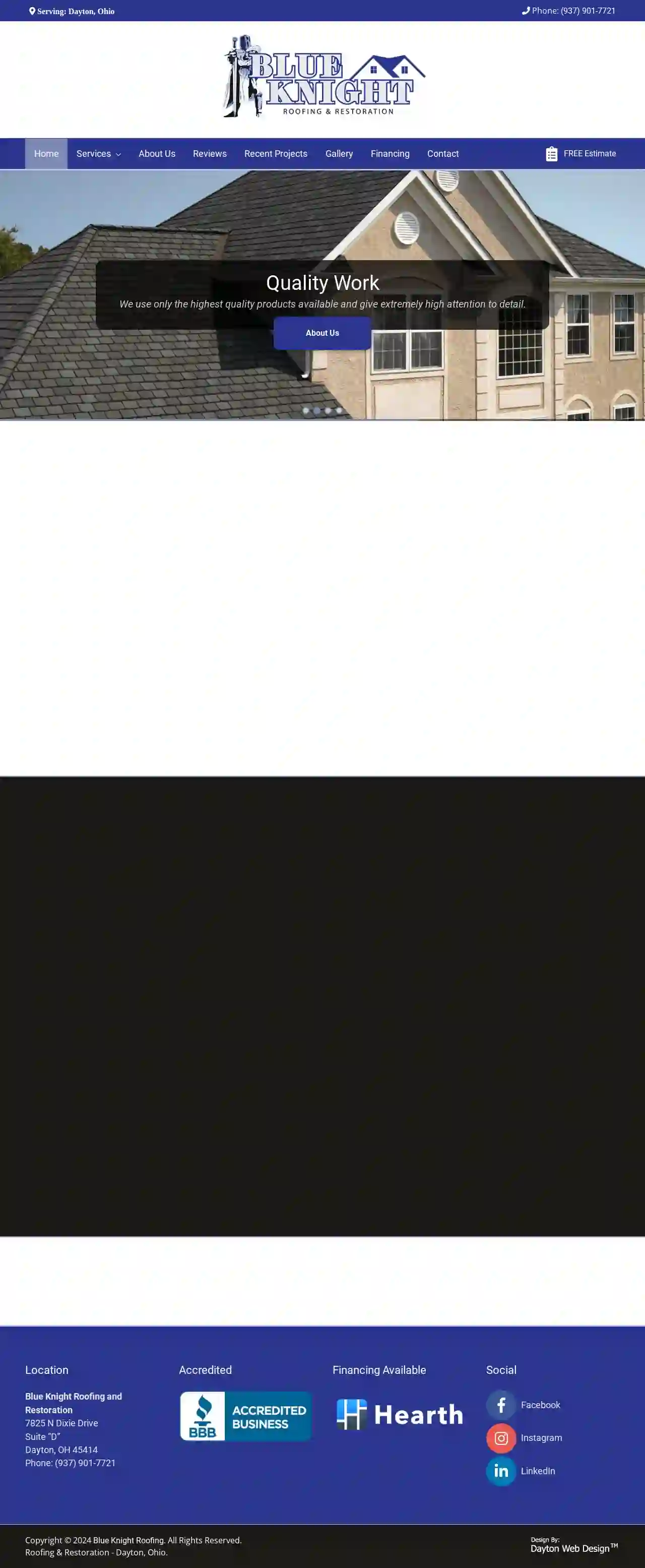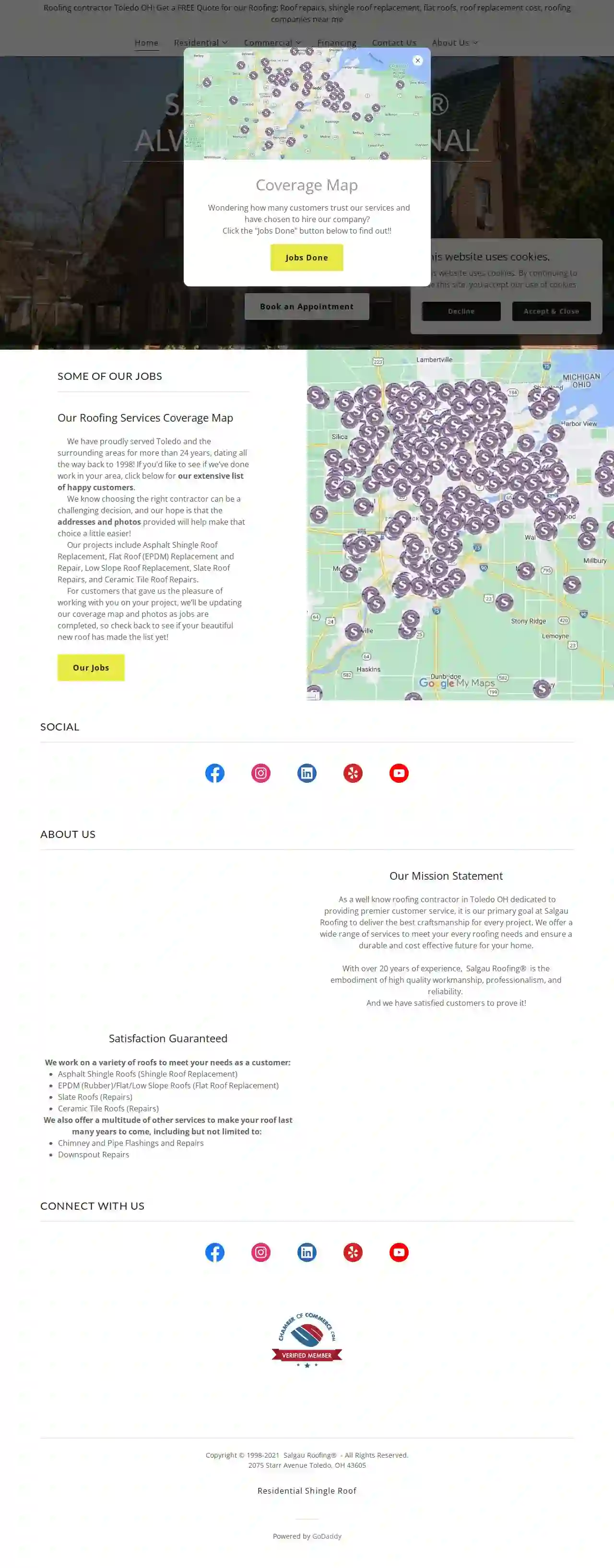Roofing Companies Wellston
Find Roofers in Wellston
Get 3 FREE Roofing Company quotes for your project today! Compare profiles, reviews, accreditations, portfolio, etc... and choose the best offer.

Figueroa Roofing And Construction LLC
58 reviews134 Buckeye St, Dayton, 45402, USFigueroa Roofing & Construction, LLC is your residential and commercial roofing contractor throughout Ohio. We work closely with our clients and design team partners to offer the best and most cost-effective solution for your building and construction needs, while maintaining the highest quality standards. We provide many services that add value and cost savings to our clients. The roof of your home is one of the few things that protects you from the elements. When it’s damaged or just not installed properly, it will be exposed to wind, rain, hail, and more. You need a roof that you can count on and that you can be proud of.
- Services
- Why Us?
- Testimonials
- Gallery
Get Quote
Roofing Done Rite LLC
4.9199 reviewsSuite 1004, 1205 Louisiana Ave, Perrysburg, 43552, USNever Pay Full Price For Your Roof Again! Save Thousands and extend the life of your Current Roof INSTANT ONLINE QUOTE SCHEDULE A FREE INSPECTION TODAY Request your free, no strings attached inspection and estimate now! Appointment Request First Name Last Name Phone Email Address City State * Zip If you are human, leave this field blank. Schedule AppointmentTOP-RATED ROOFING COMPANY Serving Northern Ohio and Fort Wayne, IndianaInstalling a roof is a big investment, which is why you should rely on our experienced roofing company. We’re known in the industry for putting our customers first and meeting their roofing needs professionally and affordably. Our customers depend on our exceptional customer service, unparalleled workmanship, and friendly approach. Contact us today for a free quote, analysis, or inspection.
- Services
- Why Us?
- Testimonials
- Gallery
Get Quote
Josh A Roofing LLC
5147 reviews5008 Chesham Dr, Huber Heights, 45424, USDayton Roofing and Gutter Repair Serving the greater Miami Valley Schedule Online Dayton Roofing and Gutter Repair Serving the greater Miami Valley Schedule Online Hi everyone, my name is Josh Alford – owner of Josh A Roofing. First and foremost, I want to say thank you for checking out our website and seeing how we can help you with your home exterior needs. We are specialists in insurance related storm damage claims, roofing, and gutters. Dayton roof & gutter contractor providing assistance after storm damage or with general replacement A little about me: I started in this industry as a Project/Sales manager of a roofing company in Cincinnati. At that company, I had the pleasure of working side by side with business partners who had over 50 years of experience in the home exterior industry. It was with that learning and development that allowed me to start our own company to reach so many more clients in the Greater Miami Valley. We take pride in every customer that we serve in the Dayton area and the work we do for them. So, whether your home has suffered damage from a big storm, or it is just time to upgrade the outside of your home, we are the company to call! We will make you our #1 priority and walk with you step by step with whatever exterior home repair you need. We have outstanding crews who will treat your property with the respect and care it deserves as you trust us with the work that needs to be done. A few examples of our work Our Gallery Dayton contractors providing excellent service across the Miami Valley We provide services in all of the areas listed below. Residential and Commercial Roofing Gutters Siding Storm Damage Interior We serve the Dayton area but also many of the surrounding cities included but not limited to: Middletown, Franklin, Lebanon, Springboro, Carlisle, Germantown, Miamisburg, West Carrollton, Moraine, Kettering, New Lebanon, Beavercreek, Xenia, Centerville, Fairborn, Enon, Springfield, Huber Heights, New Carlisle, Vandalia, Tipp City, Troy, Piqua, and Sidney. We look forward to working with you on your upcoming project.
- Services
- Why Us?
- Our Team
- Gallery
Get Quote
Toledo Roofing Contractors
Toledo, USAt Toledo Roof Contractor, our goal is your complete satisfaction with our roof work. This means providing you with best-in-industry service and products, at the most competitive prices possible, and providing you with an excellent roofing experience. We have serviced both homeowners and businesses in Toledo for more than 20 years, so you can trust that we understand the challenges of your specific roof issue, and can provide the correct solution with the highest quality work. Your roof is a essential part of your home, and our roofing work ensures that your property value increases and your family is kept safe and secure for years to come. You can have confidence that our team of professionals will do the job right. Contact your local branch 24/7 to discuss your Toledo roofer needs and schedule an inspection. We look forward to hearing from you!
- Services
- Why Us?
- Gallery
Get Quote
DIY Roofs
59 reviewsSuite 110, 1840 Airport Exchange Blvd., Erlanger, 41018, USDIY Roofs is a company that connects homeowners with roofing materials and certified, licensed, and insured roofing crews, allowing them to save money on roof replacements. Instead of using a middleman, DIY Roofs links homeowners directly to suppliers and craftsmen, eliminating unnecessary markups and commissions. The company provides a range of services, including delivering roofing materials, booking roofing crews, scheduling dumpster delivery, and coordinating project logistics. They also offer a live project manager and 24/7 support to assist homeowners throughout the process. DIY Roofs emphasizes the ease of the DIY roofing experience, stating that homeowners only need to choose the color and style of their new roof and follow a simple punch-out list. They highlight the significant cost savings homeowners can achieve by using their platform.
- Services
- Why Us?
- Gallery
Get Quote
Blue Knight Roofing and Restoration
4.998 reviewsSuite “D”, Dayton, OH, 7825 N Dixie Drive, 45414, USServing with Honor, Integrity, and Pride Blue Knight Roofing and Restoration is a full-service roofing company dedicated to providing high-quality residential roofing and exterior remodeling services in Dayton, Ohio, and the Miami Valley. We understand that your home's roof is critical for protection from the elements, which is why we prioritize using only the highest quality products and paying meticulous attention to detail. Our team of highly skilled contractors takes pride in delivering exceptional workmanship and ensuring customer satisfaction every step of the way. We strive to complete most jobs within 24 to 48 hours, minimizing disruption to your daily life. Beyond roofing, we offer a comprehensive range of services, including siding, gutters, windows, doors, storm damage repair, and soffit & fascia services. At Blue Knight Roofing and Restoration, we are committed to providing reliable, efficient, and affordable solutions for all your residential roofing and exterior needs.
- Services
- Why Us?
- Accreditations
- Our Team
- Testimonials
- Gallery
Get Quote
Salgau Roofing
4.8136 reviews2075 Starr Avenue, Toledo, 43605, USSalgau Roofing is a well-known roofing contractor in Toledo OH dedicated to providing premier customer service. With over 20 years of experience, we offer a wide range of services to meet your every roofing needs and ensure a durable and cost-effective future for your home. Our mission is to deliver the best craftsmanship for every project, and we have satisfied customers to prove it! We work on a variety of roofs, including Asphalt Shingle Roofs, EPDM (Rubber)/Flat/Low Slope Roofs, Slate Roofs, and Ceramic Tile Roofs. We also offer additional services such as Chimney and Pipe Flashings and Repairs, Downspout Repairs, and more. Our goal is to provide high-quality workmanship, professionalism, and reliability, and we have a satisfaction guarantee.
- Services
- Why Us?
- Testimonials
- Gallery
Get Quote
The Affordable Roofing Company
4.965 reviewsCincinnati, USThe Affordable Roofing Company is Cincinnati and Dayton's most affordable residential and commercial roofing company. From single-family homes to multiple Amazon warehouses, our fully insured company is ready to work. We are a company based on integrity. We provide free estimates on all jobs, and we require no money down for residential work. Commercial customers can take advantage of third-tier financing. All customers can confidently partner with us: we carry five times the coverage of a typical company, and we have very transparent processes throughout every project. We offer 100% financing to homeowners for residential roofing projects—something that truly sets us apart! Our team of skilled roofers is respectful of your home or business, and we complete projects as quickly and as safely as possible. We stand behind the work we perform, and we offer some of the best warranties in the industry.
- Services
- Why Us?
- Accreditations
- Our Team
- Gallery
Get Quote
Precision Roofing Canton
2223 Fulton DR, NW Suite 108, Canton, 44709, USPrecision Roofing - Zanesville, Ohio Roofing Company When you call Precision Roofing, our goal is to provide all of your roof service needs with outstanding customer care. We’re constantly participating in new training so that we can better serve customers and make sure they are satisfied from start to finish!From the moment you call Precision Roofing, we will make your experience a good one. Our staff is courteous and respectful which sets us apart from other companies in this industry. Precision Roofing is one of the best companies in Zanesville for roof repair, replacement, and installation. We provide services to most areas including residential homes as well as commercial properties with our technicians able to attend on-site quickly if needed.We service Zanesville, Duncan Falls, Norwich, Chandlersville, New Concord, Cambridge, Newark, and Columbus, Ohio. For emergency roofing services, contact Precision Roofing at (740) 819-8386 or fill out our contact form online. Your satisfaction is our top priority.
- Services
- Why Us?
- Gallery
Get Quote
Buckeye Roofing
4.895 reviewsOHIO, USA NAME YOU CAN TRUST. At Buckeye Roofing, we offer comprehensive roofing services, and we put quality before all other concerns. Over the years, we have handled nearly every type of roofing project imaginable, always to the complete satisfaction of our customers. We even replace siding, gutters, windows, and interiors. So no need to worry, we’ve got you covered! Here at Buckeye Roofing, we go above and beyond to make sure that your specifications are met and that you’re always completely happy with the work we’ve done. When you contact us for roofing work of any kind, you contact skilled professionals who care deeply about the quality of their work and stands behind their product. The job isn’t finished until you are completely satisfied! We will provide you with a full consultation to explain all of your available options so that you can choose the roofing plan that’s right for your home or business. We will work with you and adhere to your personal needs. Look no further for roofing in Canal Fulon or roofing in Akron. Local Ohio Contracting for over 10 years. We have been proving quality roofing in Canton OH and surround area for over a decade! Call Now 330 735 6446.
- Services
- Why Us?
- Gallery
Get Quote
Over 17,196+ Roofers on our directory
Our roofing experts operate in Wellston and beyond!
Roofyng.com has curated and vetted the Best Roofers in Wellston. Find the most trustworthy business today.
Frequently Asked Questions About Roofing Companies
- Experience: 'How long have you been in business, and what experience do you have with my type of roof?'
- Licensing and insurance: 'Are you licensed and insured, and can I see proof of coverage?'
- Warranties: 'What warranties do you offer on your work and the materials used?'
- References: 'Can you provide references from past clients?'
- Project Timeline: 'What is the estimated timeline for completing the project?'
- Payment Terms: 'What are your payment terms, and do you require a deposit?'
- Communication: 'How will you keep me updated on the project's progress?'
- Cleanup: 'What steps will you take to protect my property during the project and ensure proper cleanup afterward?'
- Age: If your roof is nearing or exceeding its expected lifespan, it's wise to consider replacement.
- Multiple Leaks: Several leaks or leaks that reappear after repairs suggest a widespread problem.
- Extensive Damage: Large areas of damaged, missing, or deteriorated roofing materials might be too costly or difficult to repair effectively.
- Sagging or Structural Issues: Sagging, deflection, or other structural issues indicate a compromised roof that needs replacement.
- Granule Loss (Asphalt Shingles): Significant granule loss indicates weathering and reduced protection.
- Curling or Buckling Shingles: Signifies age or improper ventilation.
- Increased Energy Bills: A poorly insulated roof can lead to higher heating and cooling costs.
- Roof size and complexity
- Roofing material chosen
- Local labor costs
- Accessibility of the roof
- Removal of existing roofing
- Additional features (skylights, chimneys, etc.)
- Asphalt Shingles: Popular, affordable, available in various styles (3-tab, architectural, etc.)
- Metal Roofing: Durable, long-lasting, energy-efficient, available in panels, shingles, or tiles.
- Tile Roofing: Clay, concrete, or slate; known for longevity, durability, and aesthetic appeal.
- Flat Roofing: EPDM rubber, TPO, PVC, modified bitumen, or built-up roofing (BUR).
- Slate: Natural stone, extremely durable, expensive, requires expert installation.
- Wood Shakes or Shingles: Natural wood, aesthetically pleasing, requires regular maintenance.
What questions should I ask a roofing contractor?
What are the signs that my roof needs to be replaced?
How much does a new roof cost in the USA?
What are the different types of roofing materials?
What questions should I ask a roofing contractor?
- Experience: 'How long have you been in business, and what experience do you have with similar projects?'
- Licensing and insurance: 'Are you licensed and insured, and can I see proof of coverage?'
- Warranties: 'What warranties do you offer on your work and the materials used?'
- References: 'Can you provide references from past clients?'
- Project Timeline: 'What is the estimated timeline for completing the project?'
- Payment Terms: 'What are your payment terms, and do you require a deposit?'
- Communication: 'How will you keep me updated on the project's progress?'
- Cleanup: 'What steps will you take to protect my property during the project and ensure proper cleanup afterward?'
What are the signs that my roof needs to be replaced?
- Age: If your roof is nearing or exceeding its expected lifespan, it's wise to consider replacement.
- Multiple Leaks: Several leaks or leaks that reappear after repairs suggest a widespread problem.
- Extensive Damage: Large areas of damaged, missing, or deteriorated roofing materials might be too costly or difficult to repair effectively.
- Sagging or Structural Issues: Sagging, deflection, or other structural issues indicate a compromised roof that needs replacement.
- Granule Loss (Asphalt Shingles): Significant granule loss indicates weathering and reduced protection.
- Curling or Buckling Shingles: Signifies age or improper ventilation.
- Increased Energy Bills: A poorly insulated roof can lead to higher heating and cooling costs.
How much does a new roof cost in the USA?
- Roof size and complexity
- Roofing material chosen
- Local labor costs
- Accessibility of the roof
- Removal of existing roofing
- Additional features (skylights, chimneys, etc.)
What are the different types of roofing materials?
- Asphalt Shingles: Popular, affordable, available in various styles (3-tab, architectural, etc.)
- Metal Roofing: Durable, long-lasting, energy-efficient, available in panels, shingles, or tiles.
- Tile Roofing: Clay, concrete, or slate; known for longevity, durability, and aesthetic appeal.
- Flat Roofing: EPDM rubber, TPO, PVC, modified bitumen, or built-up roofing (BUR).
- Slate: Natural stone, extremely durable, expensive, requires expert installation.
- Wood Shakes or Shingles: Natural wood, aesthetically pleasing, requires regular maintenance.